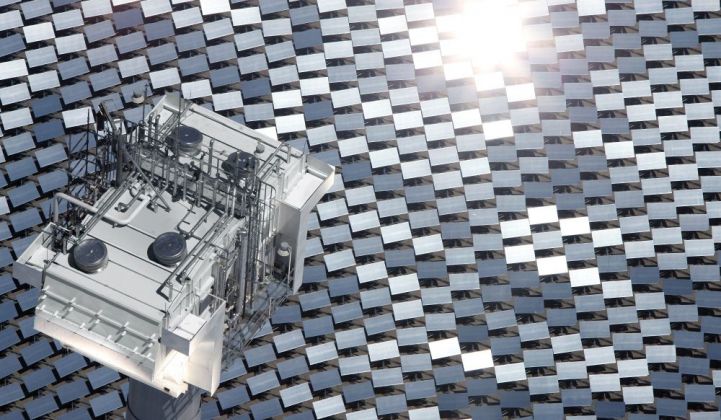Despite its big potential, concentrated solar power remains one of the most expensive mainstream options for generating renewable power.
Rather than trying to catch up through technological breakthroughs, however, the CSP industry should turn to lower-hanging fruit. That's the view of Luis Crespo, president of Protermosolar, Spain's solar thermal electricity association. Spain was a pioneer market for CSP, though it has since stalled.
CSP plants with thermal storage have greater operational and capacity value than standalone PV projects, but it's "fruitless to wait [for] electrical markets to pay more for that,” Crespo told GTM.
In the meantime, the cost gap between solar thermal towers with storage and PV or wind projects has become substantial.
Two relatively simple shifts in focus could help CSP grow its tiny share of the global renewables market, Crespo said, discussing the results of two recent research papers.
First, CSP developers should shift their focus from daytime power delivery toward nighttime and reserve power from on-site storage, building on successful recent examples. Second, plant designs should move away from huge power towers toward smaller, more modular concepts.
Bigger, not better
Power towers, among the most popular CSP designs, work by reflecting light from a large field of mirrors or heliostats onto a receiver on the top of a central tower. Many power tower projects are designed to be very large to create economies of scale during construction.
Units 2 and 3 of the Ivanpah Solar Power Facility in California, for example, generate up to 133 megawatts of power each. But such large power tower plants can suffer from poor efficiency because the distance between the CSP receiver and the heliostat field is so great that the reflected light starts to dissipate before it reaches its target, according to Crespo and co-author Francisco Ramos.
To overcome this, developers should build multiple smaller solar fields, each with a central receiver, all linked to a single large power block and storage tank. Developers should look to build standard power tower arrays of between 30 megawatts and 50 megawatts each, clustered around a single power block of up to 500 megawatts, the researchers said.
Splitting a single heliostat field into several polar field units could boost plant efficiency by 25 percent, they said.
Crespo also highlighted gains that could come from shifting dispatch profiles from hours of sunshine to evening and nighttime. That would allow plants to be smaller because they would not need to store energy at the same time as exporting it to the grid.
Some plants are already moving in this direction. In South Africa, for example, the 100-megawatt Ilanga 1 plant was commissioned last November with a power-purchase agreement that offers a 207 percent premium for electricity dispatched between 5 p.m. and 10 p.m.
Long road ahead
The unsubsidized levelized cost of energy from a new solar thermal tower with on-site storage ranges from $126 to $156 per megawatt-hour, according to the most recent analysis from Lazard. That makes CSP more expensive than geothermal energy and vastly pricier than utility-scale solar or wind, whose projects range from $28 to $44 per megawatt-hour in Lazard's reckoning.
But there are some promising signs for CSP. Earlier this year, an analysis from the International Renewable Energy Agency found that CSP's costs fell more steeply in 2018 than any other renewable technology as more projects get built in emerging markets like the Middle East and China.
Research dollars continue to go into CSP technology; Sandia National Laboratories, for instance, is said to be preparing tests of a centrifugal ceramic particle CSP receiver developed by the German Aerospace Center, DLR. The test program, being funded to the tune of $750,000 by the U.S. Department of Energy, will determine if the receiver can achieve a particle temperature of more than 1,000º C, which is expected to yield up to a 20 percent cut in the cost of energy.
While laudable, Crespo said such efforts would likely not result in bankable technologies for at least a decade or so. Instead, the industry's focus should be on operational and design changes that can be achieved with present-day technology.
He believes CSP could gain market traction against wind and PV if costs can come down to around $60 per megawatt hour.
“The technology can get there and even further,” Crespo said. “But it has to be by improving what we already have.”




